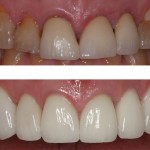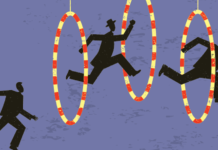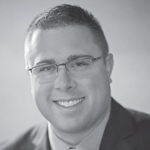
At an Arrowhead course taught by Dr. Jim Downs, I was introduced to a startling statistic: 75 percent of dentists have never prepped a full arch. I was definitely one who fit into that category. It all changed when a patient, Jeff, came to me for help.
About two years ago, Jeff walked into my office. With a hint of desperation in his voice, he asked if I could fix his teeth. His chief complaint was that his lower teeth were tearing up his lower lip and his smile was embarrassing to him.
I found Jeff’s mouth very intimidating, to say the least. He was what Dr. Downs would describe as a “blockhead brachiocephalic.” He had massive masseter muscles that seemed to say, “I will destroy anything you put in my mouth.”
Jeff’s lower anterior teeth were broken and worn down to nubs. I was not even sure they were restorable. His profile was collapsed due to dental overclosure.
Jeff’s previous dentist had recognized the need to increase his Vertical Dimension of Occlusion (VDO), and he had fit him with a lower bite splint that opened Jeff’s bite about 6mm. He wore it for several months and tolerated it well, then he lost interest after leaving that dentist due to personality differences.
I was completely honest with Jeff. I told him he needed full mouth reconstruction, but that I didn’t have the necessary skills and training to help him. If he could be patient, I would learn the skills needed and fix his teeth and his bite. I sincerely wanted to help—I couldn’t bear to see Jeff in hygiene every six months and just ignore his plea for help. He seemed satisfied with my pledge to help him. Now I felt the burden of a promise that I needed to make good on.
I had attended a couple of weekend occlusion courses that were good but left too many of my questions unanswered. I searched the Internet for different programs that taught occlusion and full mouth reconstruction. In doing so, I discovered a number of dental gurus that teach different occlusion philosophies. I just wanted a great teacher and mentor that could teach me in a way I could understand.
Then one day, my brother—a dentist in another state—called and asked if I knew anything about Arrowhead Dental and the courses they offer. Though Arrowhead is local to me, I didn’t know much about them. I did a little research and found out they taught occlusion and full mouth rehabilitation courses.
I decided to show the course instructor the pictures and models of Jeff and get his advice. In truth, I was getting a feel for Dr. Downs and his dental philosophy. I was very impressed. He took time out of his schedule to meet with me and review my case. Jim was so down to earth and easy to talk to. He told me Jeff’s case was very treatable with the right knowledge and skill set.
Dr. Downs invited me to an over-the-shoulder course where he prepped and temporized a whole arch in one afternoon while explaining the steps and procedures. The patient cried tears of joy when she saw her temporaries. I thought to myself, “I want to do that kind of dentistry.”
The next day, Dr. Downs seated a whole arch of porcelain crowns on a different patient. I really enjoyed this course. Dr. Downs was a masterful lecturer who connected well with the small group of dentists. I realized that I shared the same level of understanding as the dentists there. Other dentists in the group had been to this course before and had returned to get a deeper understanding. No question was too basic to ask Dr. Downs.
A few months later, I attended the everyday occlusion course taught by Dr. Downs. It built upon the previous course. Then I was invited to do a hands-on course where I would actually take a patient to Dr. Downs’ office to prep and temporize one weekend, then seat restorations three weeks later.
I had a major scheduling conflict, but just four weeks before the course I decided to clear my schedule and make attending a priority. I invited Jeff to be my patient. He was so excited—he was finally going to get his teeth fixed! For me to learn these new skills, I first needed to hear, then be shown, and then conclude by performing under supervision. That’s exactly what this series of courses did for me.
As part of the preparation, I took a swallow/stick bite on Jeff. This is performed by putting a cube of red rope wax on each of the lower molars. The patient puts the tip of his tongue as far back as possible and lightly bites into the wax. He then relaxes his tongue and swallows about eight times a minute. Every time he swallows, his teeth sink further into the wax cubes.
Meanwhile, the dentist uses a Boley bolley gauge to measure the distance between the cementoenamel junction (CEJ) of the upper central incisor and the CEJ of the lower central incisor. When the desired measurement is reached, a bite registration material is injected between the teeth and around the wax. This will be the patients’ new VDO.
This number is referred to as the Shimboshi number. With Jeff’s teeth closed and without the wax, his Shimboshi was 11 mm. An average person without pathological wear will be between 16 and 18 mm. I opened Jeff’s bite to 16.5mm with the swallow bite. This new VDO was similar to the bite splint Jeff was comfortable wearing. The swallow bite was sent to the Arrowhead lab, and they waxed up the case at the new VDO.
Dr. Downs and I decided we would prep and restore Jeff’s upper teeth and place splinted snowcap resin temporaries on his lower teeth. These temporaries can last 1-3 years. This would allow us to hone in his bite and let Jeff replace the lower temporaries when his budget allowed. If resin temps are not used, a lower bite splint can be worn to hold the new VDO until the lower teeth can be restored.
Before we prepped Jeff’s teeth, we evaluated his occlusion using the TekScan. This demonstrated that 72 percent of occlusal pressure occurred on the right side, opposed to 28 percent on the left side. We also performed a joint vibration analysis, demonstrating that Jeff’s TMJs were remarkably healthy despite the extensive dental pathology.
 Jeff resisted strongly when asked to smile for pre-op photos. Due to embarrassment, he had become so used to hiding his teeth when smiling and laughing that it was difficult to show them as he smiled for our camera. Dr. Downs told me that would change.
Jeff resisted strongly when asked to smile for pre-op photos. Due to embarrassment, he had become so used to hiding his teeth when smiling and laughing that it was difficult to show them as he smiled for our camera. Dr. Downs told me that would change.
Jeff tolerated prep day despite the long learning process. Dr. Downs was there every step of the way, talking me through each step. I was impressed with the Arrowhead Elite Team’s preparation. I was given prep guides showing exactly how much to prepare the teeth.
When Jeff and I flew back home to Salt Lake City, his wife was waiting for us at the airport. She cried tears of joy when she saw Jeff’s beautiful temporized teeth. She commented that it was the first time she could actually see her husband’s teeth while conversing with him. It was an emotional experience for all of us.
We placed gold crowns on the upper second molars and IPS e.max crowns on the other teeth. To the Arrowhead Elite Team’s credit, the restorations seated with very few adjustments. With the help of the Tekscan, we were able to equilibrate Jeff’s occlusion to perfection.
Jeff says his bite feels amazing. His muscles of mastication are relaxed, now that they’re at the correct physiological length. And, yes, Jeff has learned to smile.
Well, my journey still continues. When I went back to my practice, I noticed I had many patients that could benefit from this type of dentistry. I still consult with Dr. Downs and the Elite Team at Arrowhead on each case. It just makes it easier when you have such a great team to support you.









